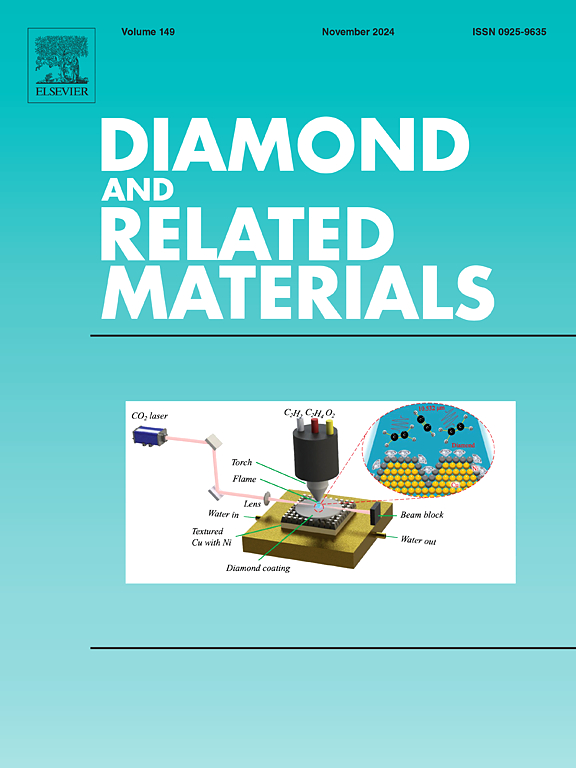水热炭化碳球微观结构对其电阻率的影响
IF 5.1
3区 材料科学
Q2 MATERIALS SCIENCE, COATINGS & FILMS
引用次数: 0
摘要
碳球(CS)在新技术领域的众多应用,促使人们对这类物体进行深入分析。本文以葡萄糖为原料,在表面活性剂的作用下,采用水热碳化法合成了CS。在第一部分的工作中,研究了表面活性剂的浓度对合成效率的影响,所得球的尺寸及其结构性质与电阻率的关系。第二部分,在固定表面活性剂浓度的条件下,在控制温度和合成时间等参数的条件下,简单、高效、可重复性地制备出单分散性高的碳球。然后对选定的三种尺寸的碳球在600至1000°C的温度范围内退火进行了详细分析。CS结果表明,其表面形貌、微观结构、孔隙率和电阻率与加工温度密切相关。这些结论是基于扫描电镜、拉曼光谱、x射线衍射、热重分析、氮吸附分析和电阻率测量。比表面积(SSA)和孔体积随退火温度和球尺寸的变化而变化,对多孔结构的发育有显著影响。在200 ~ 400 nm尺寸范围内,球体尺寸对样品电阻率无明显影响。主要影响因素是石墨化过程、SSA和孔隙体积的变化。在所有退火温度下,电阻率最高的样品始终表现出最大的SSA。本文章由计算机程序翻译,如有差异,请以英文原文为准。

Influence of microstructure on electrical resistivity of hydrothermal carbonization-derived carbon spheres
The numerous applications of carbon spheres (CS) in the field of new technologies, prompt a deep analysis of such objects. In the present work, CS were synthesized by hydrothermal carbonization (HTC) based on glucose with the surfactant. In the first part of the work, the effect of the concentration of the surfactant used in the synthesis on the efficiency of the process, the size of the obtained spheres and the relationship between their structural properties and electrical resistivity were studied. In the second part, based on a fixed surfactant concentration, it was shown how to obtain carbon spheres with high monodispersity in an easy, efficient and reproducible way, controlling parameters such as temperature and synthesis time. A detailed analysis of selected three sizes of carbon spheres annealed over a temperature range of 600 to 1000 °C was then carried out. The CS results showed that their surface morphology, microstructure, porosity and electrical resistivity strongly depend on the processing temperature. These conclusions are based on scanning electron microscopy, Raman spectroscopy, X-ray diffraction, thermogravimetric analysis, nitrogen adsorption analysis and resistivity measurements. The specific surface area (SSA) and pore volume varied with annealing temperature and sphere size, significantly influencing the development of the porous structure. In the 200–400 nm size range, sphere size had no clear effect on sample resistivity. The dominant factors were graphitization processes and changes in SSA and pore volume. Across all annealing temperatures, samples with the highest resistivity consistently exhibited the largest SSA.
求助全文
通过发布文献求助,成功后即可免费获取论文全文。
去求助
来源期刊

Diamond and Related Materials
工程技术-材料科学:综合
CiteScore
6.00
自引率
14.60%
发文量
702
审稿时长
2.1 months
期刊介绍:
DRM is a leading international journal that publishes new fundamental and applied research on all forms of diamond, the integration of diamond with other advanced materials and development of technologies exploiting diamond. The synthesis, characterization and processing of single crystal diamond, polycrystalline films, nanodiamond powders and heterostructures with other advanced materials are encouraged topics for technical and review articles. In addition to diamond, the journal publishes manuscripts on the synthesis, characterization and application of other related materials including diamond-like carbons, carbon nanotubes, graphene, and boron and carbon nitrides. Articles are sought on the chemical functionalization of diamond and related materials as well as their use in electrochemistry, energy storage and conversion, chemical and biological sensing, imaging, thermal management, photonic and quantum applications, electron emission and electronic devices.
The International Conference on Diamond and Carbon Materials has evolved into the largest and most well attended forum in the field of diamond, providing a forum to showcase the latest results in the science and technology of diamond and other carbon materials such as carbon nanotubes, graphene, and diamond-like carbon. Run annually in association with Diamond and Related Materials the conference provides junior and established researchers the opportunity to exchange the latest results ranging from fundamental physical and chemical concepts to applied research focusing on the next generation carbon-based devices.
 求助内容:
求助内容: 应助结果提醒方式:
应助结果提醒方式:


